Orthopoxvirus is a genus of large, brick-shaped, double-stranded DNA viruses DNA Viruses Viruses whose nucleic acid is DNA. Virology. Several clinically relevant species exist, including variola virus Virus Viruses are infectious, obligate intracellular parasites composed of a nucleic acid core surrounded by a protein capsid. Viruses can be either naked (non-enveloped) or enveloped. The classification of viruses is complex and based on many factors, including type and structure of the nucleoid and capsid, the presence of an envelope, the replication cycle, and the host range. Virology (the cause of smallpox), monkeypox virus Virus Viruses are infectious, obligate intracellular parasites composed of a nucleic acid core surrounded by a protein capsid. Viruses can be either naked (non-enveloped) or enveloped. The classification of viruses is complex and based on many factors, including type and structure of the nucleoid and capsid, the presence of an envelope, the replication cycle, and the host range. Virology, vaccinia virus Virus Viruses are infectious, obligate intracellular parasites composed of a nucleic acid core surrounded by a protein capsid. Viruses can be either naked (non-enveloped) or enveloped. The classification of viruses is complex and based on many factors, including type and structure of the nucleoid and capsid, the presence of an envelope, the replication cycle, and the host range. Virology, and cowpox virus Virus Viruses are infectious, obligate intracellular parasites composed of a nucleic acid core surrounded by a protein capsid. Viruses can be either naked (non-enveloped) or enveloped. The classification of viruses is complex and based on many factors, including type and structure of the nucleoid and capsid, the presence of an envelope, the replication cycle, and the host range. Virology. Transmission varies depending on the species but can be through contact with infected bodily secretions, skin Skin The skin, also referred to as the integumentary system, is the largest organ of the body. The skin is primarily composed of the epidermis (outer layer) and dermis (deep layer). The epidermis is primarily composed of keratinocytes that undergo rapid turnover, while the dermis contains dense layers of connective tissue. Skin: Structure and Functions lesions, or fomites Fomites Inanimate objects that carry pathogenic microorganisms and thus can serve as the source of infection. Microorganisms typically survive on fomites for minutes or hours. Common fomites include clothing, tissue paper, hairbrushes, and cooking and eating utensils. Adenovirus. Smallpox is the most severe disease, presenting with constitutional symptoms Constitutional Symptoms Antineutrophil Cytoplasmic Antibody (ANCA)-Associated Vasculitis and a diffuse, well-circumscribed maculopapular Maculopapular Dermatologic Examination rash Rash Rocky Mountain Spotted Fever that progresses through an evolutionary process that results in scarring Scarring Inflammation. Smallpox is associated with a high mortality Mortality All deaths reported in a given population. Measures of Health Status rate. Monkeypox presents similarly but has lower mortality Mortality All deaths reported in a given population. Measures of Health Status and is associated with lymphadenopathy Lymphadenopathy Lymphadenopathy is lymph node enlargement (> 1 cm) and is benign and self-limited in most patients. Etiologies include malignancy, infection, and autoimmune disorders, as well as iatrogenic causes such as the use of certain medications. Generalized lymphadenopathy often indicates underlying systemic disease. Lymphadenopathy. Vaccinia and cowpox produce milder disease with localized lesions acquired from direct skin-to-skin contact. These infections Infections Invasion of the host organism by microorganisms or their toxins or by parasites that can cause pathological conditions or diseases. Chronic Granulomatous Disease are diagnosed with the aid of PCR PCR Polymerase chain reaction (PCR) is a technique that amplifies DNA fragments exponentially for analysis. The process is highly specific, allowing for the targeting of specific genomic sequences, even with minuscule sample amounts. The PCR cycles multiple times through 3 phases: denaturation of the template DNA, annealing of a specific primer to the individual DNA strands, and synthesis/elongation of new DNA molecules. Polymerase Chain Reaction (PCR), serology Serology The study of serum, especially of antigen-antibody reactions in vitro. Yellow Fever Virus, viral culture Viral culture West Nile Virus, and/or electron microscopy. There are no known treatments for these diseases, and management is generally supportive. Vaccination Vaccination Vaccination is the administration of a substance to induce the immune system to develop protection against a disease. Unlike passive immunization, which involves the administration of pre-performed antibodies, active immunization constitutes the administration of a vaccine to stimulate the body to produce its own antibodies. Vaccination has led to the eradication of smallpox.
Last updated: Dec 29, 2023
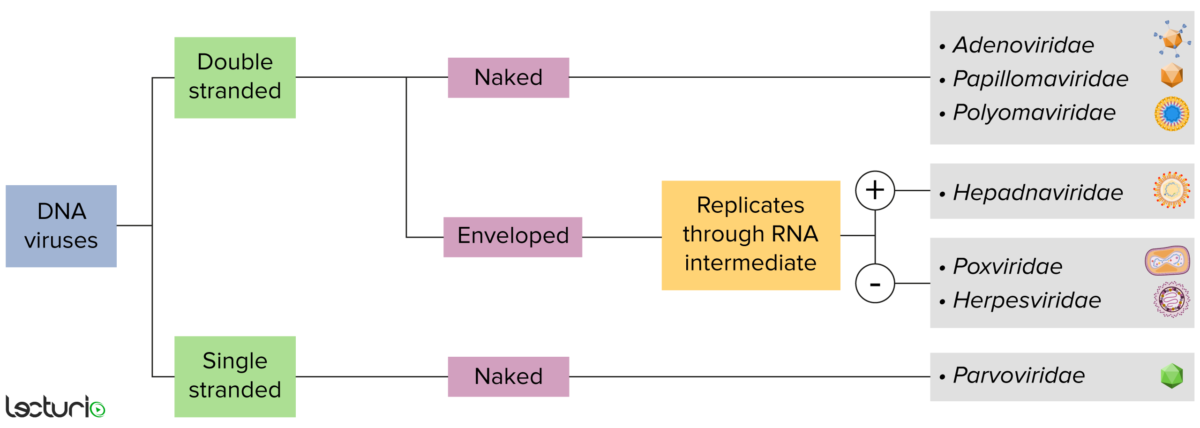
Identification of DNA viruses:
Viruses can be classified in many ways. Most viruses, however, will have a genome formed by either DNA or RNA. Viruses with a DNA genome can be further characterized as single or double stranded. “Enveloped” viruses are covered by a thin coat of cell membrane, which is usually taken from the host cell. If the coat is absent, however, the viruses are called “naked” viruses. Some enveloped viruses translate DNA into RNA before incorporating into the genome of the host cell.
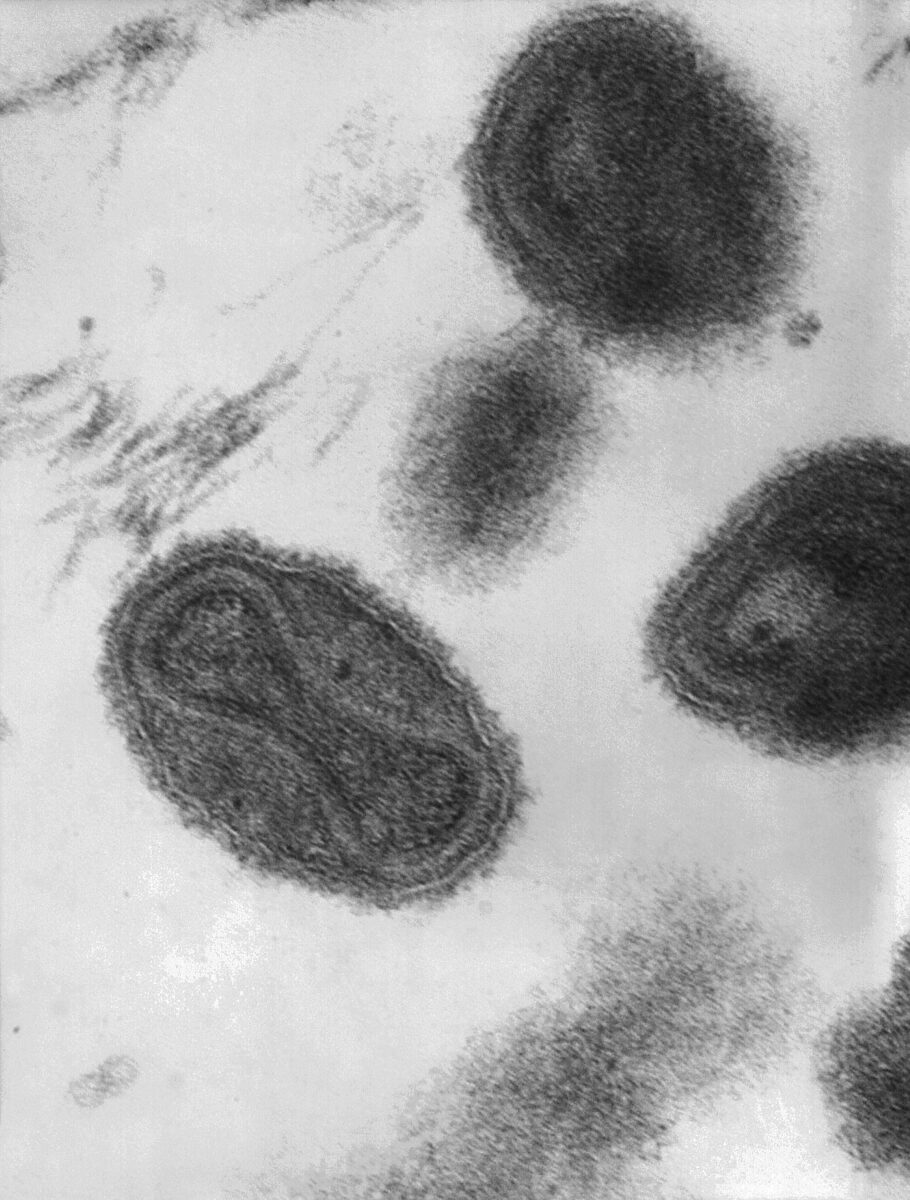
This transmission electron micrograph depicts a number of smallpox virions:
The dumbbell-shaped structure inside the virion is the viral core, which contains the viral DNA.
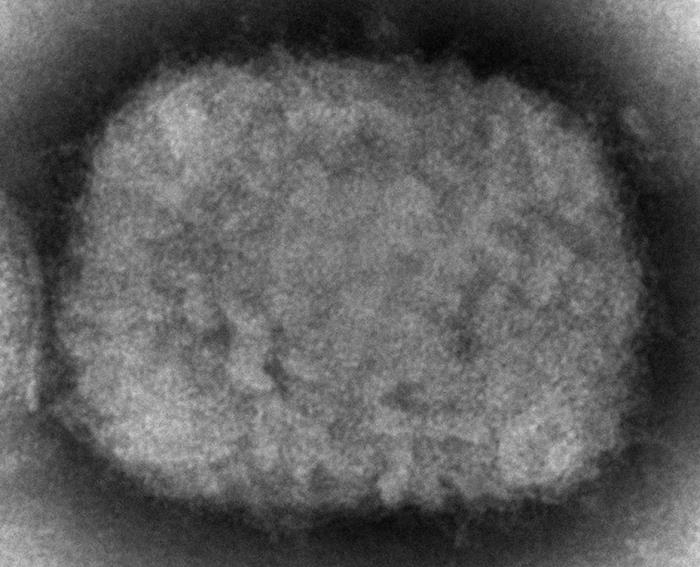
Transmission electron microscopic image depicting a monkeypox virion:
This negative-stain image shows a single, brick-shaped particle covered with whorled filaments.
Notable orthopoxviruses that infect humans include:
| Virus Virus Viruses are infectious, obligate intracellular parasites composed of a nucleic acid core surrounded by a protein capsid. Viruses can be either naked (non-enveloped) or enveloped. The classification of viruses is complex and based on many factors, including type and structure of the nucleoid and capsid, the presence of an envelope, the replication cycle, and the host range. Virology | Reservoir Reservoir Animate or inanimate sources which normally harbor disease-causing organisms and thus serve as potential sources of disease outbreaks. Reservoirs are distinguished from vectors (disease vectors) and carriers, which are agents of disease transmission rather than continuing sources of potential disease outbreaks. Humans may serve both as disease reservoirs and carriers. Escherichia coli | Transmission |
|---|---|---|
| Smallpox | Humans |
|
| Monkeypox | Unknown (maybe small rodents) |
|
| Vaccinia | Unknown | Skin-to-skin contact (often from those recently vaccinated) |
| Cowpox | Rodents | Direct contact with infected animals Animals Unicellular or multicellular, heterotrophic organisms, that have sensation and the power of voluntary movement. Under the older five kingdom paradigm, animalia was one of the kingdoms. Under the modern three domain model, animalia represents one of the many groups in the domain eukaryota. Cell Types: Eukaryotic versus Prokaryotic (often cows, cats) |
More severe disease tends to occur in:
The following table summarizes notable clinical diseases caused by orthopoxviruses:
| Disease | Incubation Incubation The amount time between exposure to an infectious agent and becoming symptomatic. Rabies Virus | Constitutional symptoms Constitutional Symptoms Antineutrophil Cytoplasmic Antibody (ANCA)-Associated Vasculitis | Rash Rash Rocky Mountain Spotted Fever |
|---|---|---|---|
| Smallpox | 7–19 days |
|
|
| Monkeypox | 5–21 days |
|
|
| Vaccinia | 2–4 days |
|
|
| Cowpox | 2–4 days |
|
|
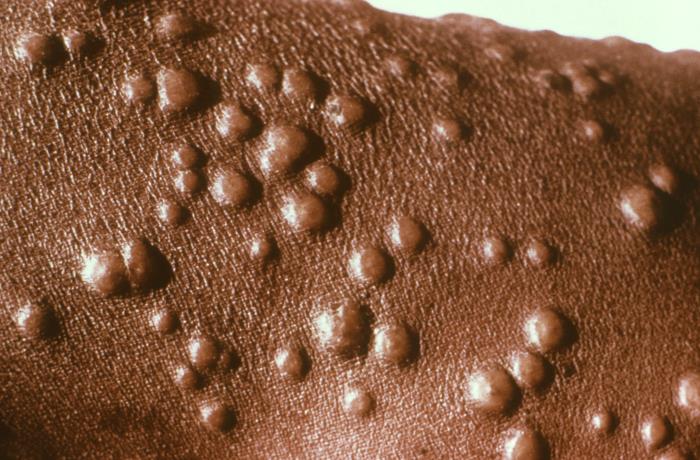
Characteristic papular rash that spread over the skin of the neck and upper back in a patient with smallpox
Image: “Young patient had been infected with the smallpox virus” by CDC/ Dr. Paul B. Dean. License: Public Domain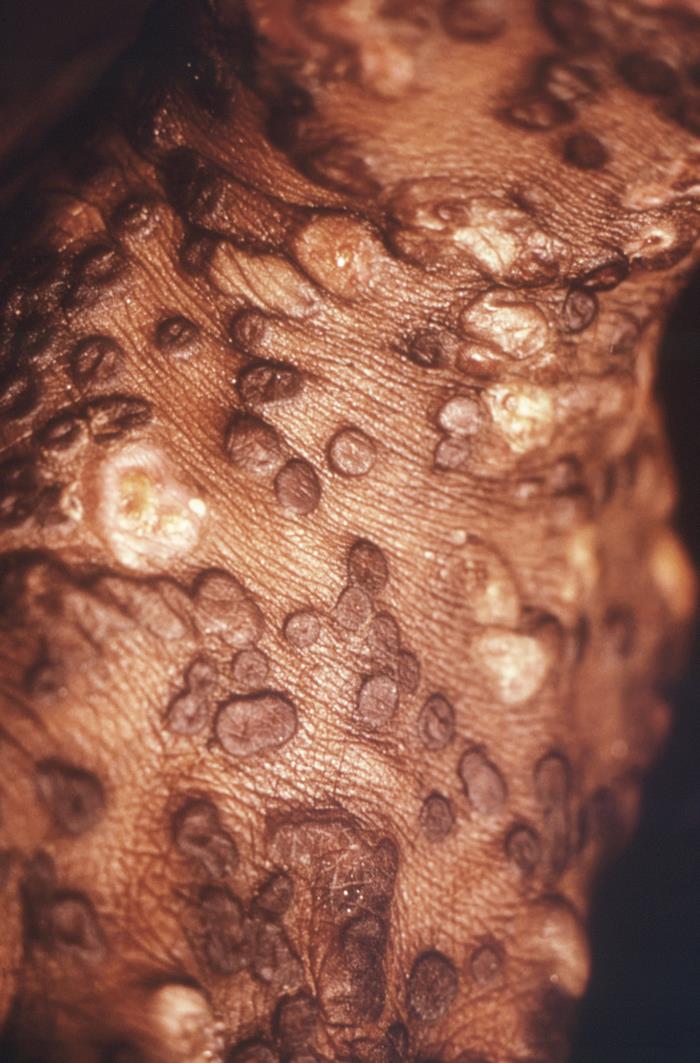
At this point in the disease’s progress, the lesions had entered their later stages of development, beginning to crust over, eventually forming scabs.
The scabs would then slough off to leave cutaneous scars (in the form of numerous pockmarks).
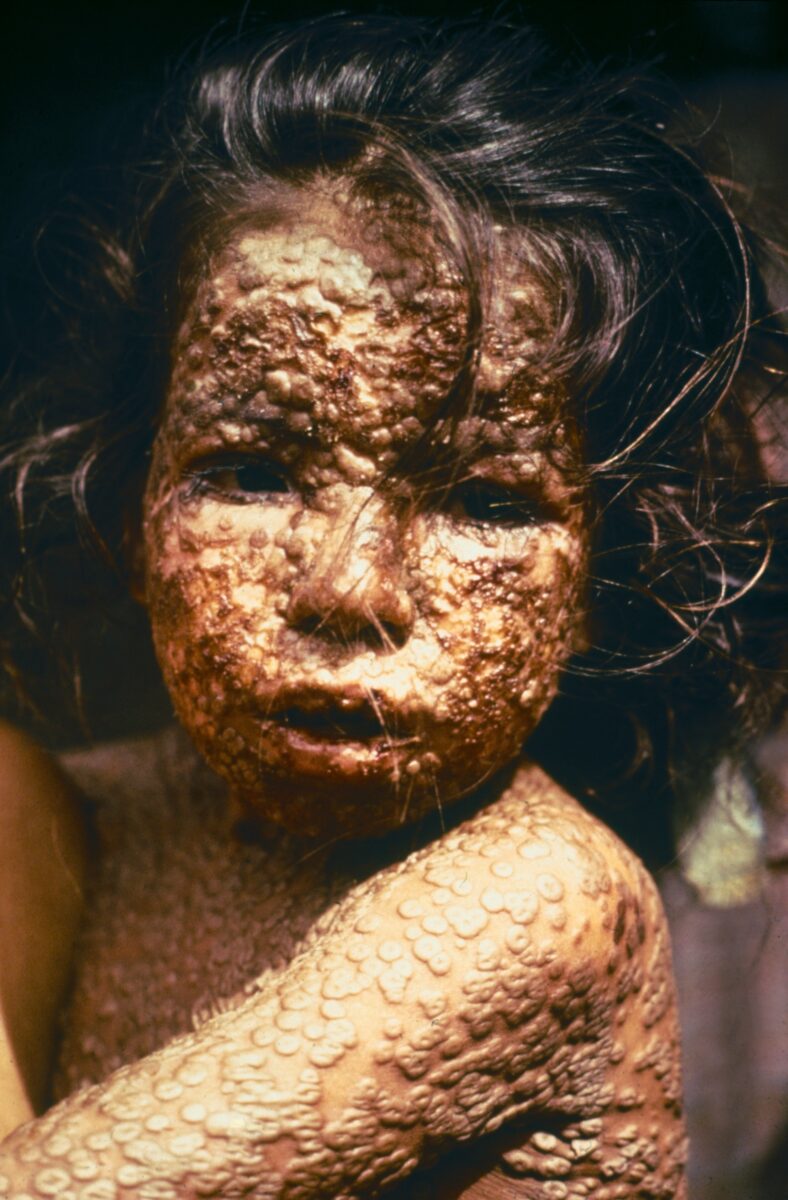
Child infected with smallpox
Image: “This young girl in Bangladesh was infected with smallpox in 1973” by CDC/ James Hicks. License: Public Domain
Intraoral view of a semi-confluent crop of maculopapular vesicles that appeared during the early stages of smallpox
Image: “This intraoral view depicted the palatal mucosa of a 53-year-old female” by CDC/ Dr. R. Robinson. License: Public Domain
Young boy with the characteristic maculopapular monkeypox cutaneous rash, which resembles the rash caused by the smallpox virus
Image: “This 1997 image was created during an investigation into an outbreak of monkeypox, which took place in the Democratic Republic of the Congo (DRC), formerly Zaire” by World Health Organization (WHO)/ Brian W.J. Mahy. License: Public Domain
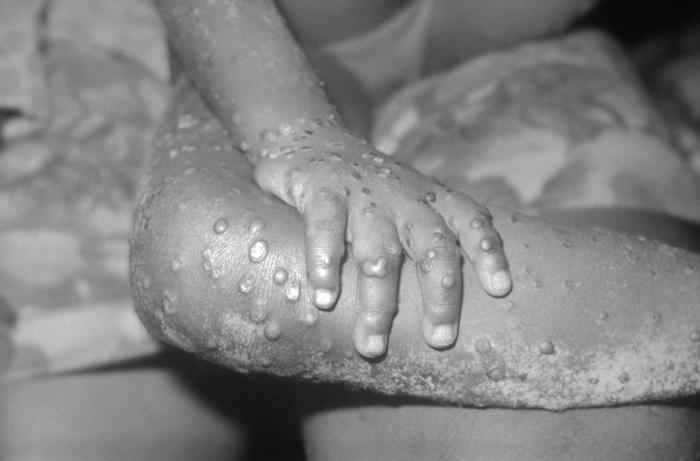
Numerous maculopapular monkeypox lesions on a young patient.
Image: “This image from 1971, depicts a view of the right hand and leg, of a 4 year-old female in Bondua, Grand Gedeh County, Liberia” by CDC. License: Public Domain
The face of a young man who had recovered from a case of monkeypox, bearing the permanent pock mark scars on his skin
Image: “This 1997 image was created during an investigation into an outbreak of monkeypox, which took place in the Democratic Republic of the Congo (DRC), formerly Zaire” by World Health Organization (WHO)/ Brian W.J. Mahy. License: Public Domain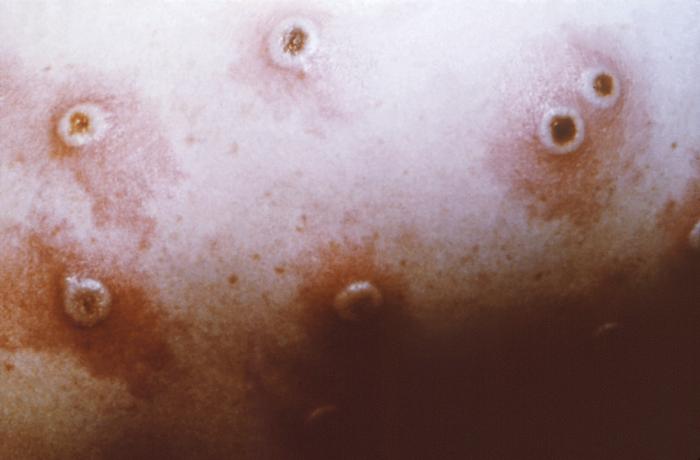
20-year-old male who was accidentally, heterogeneously inoculated with vaccinia after having worn a jersey that had been worn by a newly vaccinated friend.
Image: “This 1962 photograph depicted a close view of the skin of a 20-year-old male who was accidentally, heterogeneously inoculated with vaccinia, after having worn a jersey that had been worn by a newly vaccinated friend” by CDC/ Dr. R. Robinson. License: Public Domain
A 21-month-old boy who developed a secondary facial vaccinial infection (after smallpox vaccination) that involved both eyes and bilateral periorbital areas
Image: “A post-smallpox vaccination complication, this 21-month-old male infant developed a secondary facial vaccinial infection involving both eyes, and bilateral periorbital areas” by CDC. License: Public Domain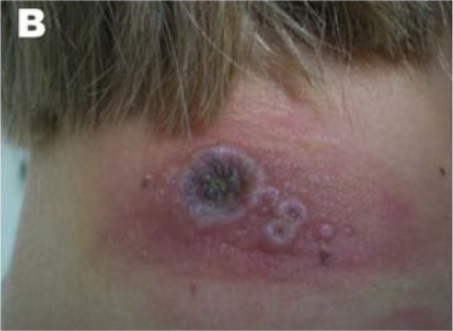
Neck lesions on a girl who contracted cowpox
Image: “Clinical presentation of cowpox lesions on rats and humans during an outbreak in Germany, 2009” by Reynolds MG et al. License: CC BY 3.0, cropped by Lecturio.The diagnosis can be supported with the following testing:
The smallpox vaccine Vaccine Suspensions of killed or attenuated microorganisms (bacteria, viruses, fungi, protozoa), antigenic proteins, synthetic constructs, or other bio-molecular derivatives, administered for the prevention, amelioration, or treatment of infectious and other diseases. Vaccination is not only responsible for the eradication of smallpox but also appears to: